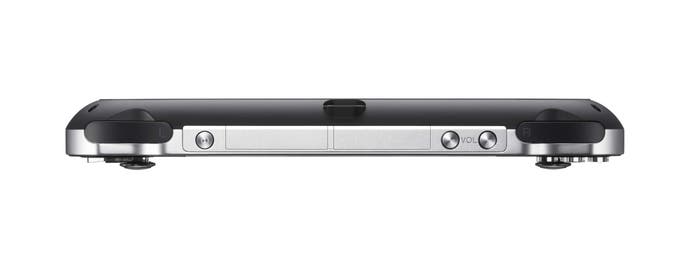Digital Foundry Sony NGP analysis
"Next Generation Portable sets a new standard for mobile gaming performance."
A bit of an unknown right about now concerns the clock speed of the CPU and GPU. We know of at least one major manufacturer running early prototypes of the SGX543 MP4+ at 400MHz back in 2009, and this shouldn't be a problem even at 45nm, but at the same time it is understood that NGP's original slide-screen configuration was ditched in favour of the traditional PSP-shaped design owing to heat issues. With the iPad GPU thought to be operating at 250MHz, downclocking NGP's chip may make sense and would of course have implications for battery life.
Away from the raw specs of the innards, NGP impresses elsewhere too. The front touch-screen is welcome, of course, but the rear pad that maps directly to the front display should also allow for much more nuanced control - plus the ability to work in an almost 3D fashion, as demonstrated during Sony's event. Three-axis motion sensors and gyroscopes suggest a precision equivalent to PlayStation Move, while the inclusion of a three-axis compass and GPS opens up the possibility for NGP being used as device with more conventional App-style functionality.
It is intriguing to see that Sony's answer to the question of mobile gaming is effectively an evolution of what it came up with for the original PSP - a surfeit of computational and graphical power that effectively annihilates all competition. But is this the answer to a question that nobody is really asking any more? Handheld gaming has radically changed since 2004: Nintendo DS proved conclusively that concept-driven titles work more effectively on the move than home console ports. The rise of the iOS devices and the supreme dominance of titles like the Tap Tap Revenge games, Angry Birds and Flight Control suggests that raw graphical power is low on gamers' priorities.
By revealing games like Uncharted, WipEout and Resistance, Sony is positioning NGP very much as a platform for core gamers. Crucially, the major brands and the key first-party developers are working on the launch - a level of commitment that signals a clear statement of intent from the platform holder, and something that was painfully lacking in the launch of PlayStation Move.
In addition to that, during Kojima's Metal Gear presentation there was very much a feeling that we could be seeing NGP as a mobile extension of the PlayStation 3 itself on certain titles, with the same games operating on both platforms and progress saved in the Cloud. While Kojima's demonstration of a pared-back Metal Gear Solid 4 (still operating with many PS3-level assets) puts paid to the notion that NGP offers the same level of processing power as the PlayStation 3, it does at least suggest that with careful nipping and tucking, an equivalent mobile experience can be created.
It also demonstrates in spectacular style that NGP is significantly more powerful than the Nintendo 3DS. Even factoring in the stereoscopic resolution of 800x240, NGP is still operating with over 2.5 times as many pixels, plus the Lost Planet 2 demonstration was a strong indication that support for the full OpenGL 2.0 ES feature-set presents visual capabilities that the 3DS struggles to match. What we saw here was a considerably richer visual experience than what has been seen in Capcom's equivalent work on Resident Evil: Revelations. Behind the magical stereoscopic effect and some of the GPU effects, there's still a sense that 3DS feels like a Dreamcast or PS2-level of hardware while NGP reaches - and almost seems to reach - the next generation.


So are there any disappointments in the spec? Well, there's a strong sense from Sony that NGP is for mobile gaming while PS3 remains the console of choice for the home experience, and it feels as though the platform holder is making sure that the new handheld doesn't tread on PS3's toes. There was no announcement for any kind of HDMI support from the handheld at the press event, and SCEE confirmed to us this morning that "NGP does not have a video output feature".
Sony can quite rightly point out that its mobile games are designed to be played on the move, on the exact screen it has specified, but the fact is that phones and tablets are swiftly moving on to support HDMI connectivity. It allows your device to operate as a portable media machine when you're out and about, and obviously allows for more comfortable web browsing.
Many more questions remain unanswered too. In addition to the clock speeds of the CPU and GPU, onboard memory (thought to be at 1GB, though the OS will occupy an area of this) remains unconfirmed, and uncertainty still surrounds the expansion capabilities of the unit: Memory Stick? SD card? Or will Sony opt for an Apple-style fixed amount of onboard flash RAM as it did in the PSPgo and perhaps offer multiple SKUs?
Expect clarification on some of these issues as Sony talks in more depth to the press.








